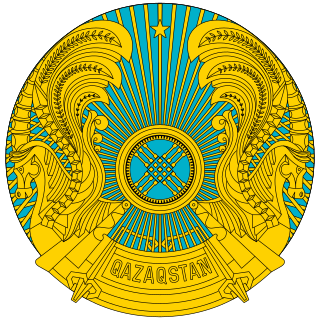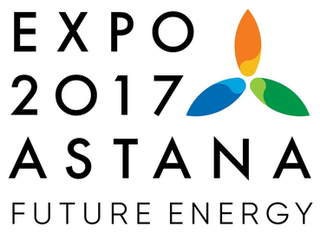Related Research Articles

Kazakhstan, officially the Republic of Kazakhstan, is a transcontinental country largely located in Central Asia with the most western parts of it being located in Europe. It is the world's largest landlocked country, and the ninth-largest country in the world, with an area of 2,724,900 square kilometres (1,052,100 sq mi). Kazakhstan is the most dominant nation of Central Asia economically, generating 60% of the region's GDP, primarily through its oil and gas industry. It also has vast mineral resources.

The economy of Kazakhstan is the largest in Central Asia in both absolute and per capita terms, but the currency saw a sharp depreciation between 2013 and 2016. It possesses oil reserves as well as minerals and metals. It also has considerable agricultural potential with its vast steppe lands accommodating both livestock and grain production. The mountains in the south are important for apples and walnuts; both species grow wild there. Kazakhstan's industrial sector rests on the extraction and processing of these natural resources.

Foreign relations of Kazakhstan are primarily based on economic and political security. The Nazarbayev administration has tried to balance relations with Russia and the United States by sending petroleum and natural gas to its northern neighbor at artificially low prices while assisting the U.S. in the War on Terror. Kazakhstan is a member of the United Nations, Organization for Security and Co-operation in Europe, North Atlantic Cooperation Council, Commonwealth of Independent States, the Shanghai Cooperation Organisation, and NATO's Partnership for Peace program. Kazakhstan established a customs union with Russia and Belarus, transformed into the Eurasian Economical Community then in 2015 into the Eurasian Economic Union. President Nazarbayev has prioritized economic diplomacy into Kazakhstan's foreign policy.

Nur-Sultan, previously named Astana from 1998 to 2019, is the capital city of Kazakhstan. In March 2019, it was renamed to Nur-Sultan after the departing Kazakh president, Nursultan Nazarbayev. It stands on the banks of the Ishim River in the northern portion of Kazakhstan, within the Akmola Region, though administered separately from the region as a city with special status. A 2017 official estimate reported a population of 1,029,556 within the city limits, making it the second-largest city in the country, behind Almaty, the capital from 1991 to 1997.

The president of the Republic of Kazakhstan is the head of state, commander-in-chief and holder of the highest office within the Republic of Kazakhstan. The powers of this position are described in a special section of the Constitution of Kazakhstan.

Human rights in Kazakhstan are uniformly described as poor by independent observers. Human Rights Watch says that "Kazakhstan heavily restricts freedom of assembly, speech, and religion. In 2014, authorities closed newspapers, jailed or fined dozens of people after peaceful but unsanctioned protests, and fined or detained worshipers for practicing religion outside state controls. Government critics, including opposition leader Vladimir Kozlov, remained in detention after unfair trials. Torture remains common in places of detention."

Erlan Abilfayizuly Idrissov was the Foreign Minister of the Republic of Kazakhstan 1999 to 2002 and 2012 to 2016. He previously served as Foreign Minister in the Government of Kazakhstan from 1999−2002.

Kazakhstan – United Kingdom relations were formally established on 19 January 1992. The UK opened an embassy in Kazakhstan in October 1992 and Kazakhstan opened an embassy in the UK in February 1996. Kazakhstan's relations with the West have greatly improved in the last few years as the Government has closely cooperated in the U.S.-led War on Terror. See also: Counter-terrorism in Kazakhstan

The United States and the Republic of Kazakhstan established diplomatic relations on December 16, 1991. The United States opened its embassy in Almaty in January 1992 and then relocated to Nur-Sultan in 2006.

Kazakhstan owns large reserves of energy resources, and therefore the energy policy of Kazakhstan has influence over the world's overall energy supply. Although Kazakhstan has not described itself as an energy superpower, Kazakhstan's former president Nursultan Nazarbayev has claimed Kazakhstan will become a factor of energy security in Asia and Europe. Kazakhstan has a strategic geographical location to control oil and gas flows from Central Asia to East (China) and West.
Women in Kazakhstan are women who live in or are from Kazakhstan. Their position in society has been and is influenced by a variety of factors, including local traditions and customs, decades of Soviet regime, rapid social and economic changes and instability after independence, and new emerging Western values.

Expo 2017 Astana was an International Exposition which took place from June 10 to September 10, 2017 in Astana, Kazakhstan. The expo's theme was "Future Energy", and aimed to create a global debate between countries, nongovernmental organizations, companies and the general public on the crucial question: "How do we ensure safe and sustainable access to energy for all while reducing CO2 emissions?"

European Union–Kazakhstan relations are the international relations between the Republic of Kazakhstan and the common foreign policy and trade relations of the European Union.

The Astana Economic Forum (AEF) is an international and regional platform for dialogue and a non-profit organization headquartered in Nur-Sultan, Kazakhstan. It was organized by the Eurasian Economic Club of Scientists Association and the Government of Kazakhstan in 2008. After a decade the forum is taking on an additional name - The Global Challenges Summit - to reflect the topics and draw of attendees from around the world. Since 2015 the Forum is organized by the Economic Initiatives Fund of Kazakhstan, which is a part of the Economic Research Institute under the Ministry of National Economy. A meeting is held each year in Nur-Sultan in which more than eight thousand delegates from one hundred countries are brought together: They include chief executive officers of businesses, politicians, journalists, scientists and Nobel Prize laureates.

Kazakh President Nursultan Nazarbayev announced the Kazakhstan 2050 Strategy during his annual state of the nation address on December 15, 2012. The 2050 Strategy calls for widespread economic, social and political reforms to position Kazakhstan among the top 30 global economies by 2050.
Nurly Zhol is a $9 billion domestic economic stimulus plan to develop and modernize roads, railways, ports, IT infrastructure, and education and civil services in the Republic of Kazakhstan. The Nurly Zhol plan was announced by Kazakhstan's President Nursultan Nazarbayev in November 2014.
There is enormous potential for renewable energy in Kazakhstan, particularly from wind and small hydropower plants. The Republic of Kazakhstan has the potential to generate 10 times as much power as it currently needs from wind energy alone. But renewable energy accounts for just 0.6 percent of all power installations. Of that, 95 percent comes from small hydropower projects. The main barriers to investment in renewable energy are relatively high financing costs and an absence of uniform feed-in tariffs for electricity from renewable sources. The amount and duration of renewable energy feed-in tariffs are separately evaluated for each project, based on feasibility studies and project-specific generation costs. Power from wind, solar, biomass and water up to 35 MW, plus geothermal sources, are eligible for the tariff and transmission companies are required to purchase the energy of renewable energy producers. An amendment that introduces and clarifies technology-specific tariffs is now being prepared. It is expected to be adopted by Parliament by the end of 2014. In addition, the World Bank's Ease of Doing Business indicator shows the country to be relatively investor-friendly, ranking it in 10th position for investor protection.

The Astana International Financial Centre (AIFC) is a financial hub in Nur-Sultan, Kazakhstan that officially launched on July 5, 2018.
Science and technology in Kazakhstan outlines government policies to develop science, technology and innovation in Kazakhstan.

The Republic of Kazakhstan became a member of the UN on March 2, 1992. Membership in the international organization has given Kazakhstan, in the context of globalization, the opportunity to participate fully in international cooperation and solving international problems of a political, economic, environmental, social, cultural and humanitarian character.
References
- ↑ "Conception of Kazakhstan on transition to green economy". Kazcontent. Archived from the original on 2014-07-19. Retrieved 2013-11-20.
- ↑ "Green Technologies Learning Centre Kicks off to Support Transition to Green Economy". astanatimes.com.
- 1 2 "Kazakhstan Sets Prices for Energy from Renewable Sources". Bloomberg News.
- 1 2 "Kazakhstan tackles its electronic waste problem". UNDP. Retrieved 2015-10-05.
- ↑ "UNDP, Kazakh Government implement emissions abatement project in country's 15 cities". www.inform.kz.
- 1 2 "Nazarbayev Signs Law to Promote Green Economy Development". astanatimes.com.
- ↑ "EIB Provides EUR 200m To Support Green Projects In Kazakhstan". blueandgreentomorrow.com.
- ↑ "President approves Kazakhstan transition to 'green economy'". Kazakhstan Chamber of Commerce in the USA.
- ↑ "Key things to know on renewable energy projects' implementation in Kazakhstan". thelawyer.com. Archived from the original on 2015-09-06. Retrieved 2015-09-03.
- ↑ "Kazakhstan to use one third of its wastes to generate 'green' energy". Tengrinews.
- ↑ "Wind generators in NKazakhstan". bnews.kz. Archived from the original on 2014-02-03. Retrieved 2014-01-31.
- ↑ "Wind power stations in South Kazakhstan". strategy2050.kz.
- ↑ "KazAgroFinance adopts financing of renewable energy program in agriculture". strategy2050.kz.
- ↑ "Kazakhstan plans new renewable energy facilities". www.globalconnections.hsbc.com.
- ↑ "Bisol installed 2 MW solar power plant". www.bisol.com.
- ↑ "Law on the transition to a green economy presented in Kazakhstan". www.lexology.com.
- ↑ "Green Bridge Partnership Programme 2011-2020". United Nations.
- 1 2 "OSCE Programme Office in Astana promotes regional Green Bridge Partnership Programme". www.osce.org.
- ↑ "OSCE supports platform for promoting best practices and innovations for a green economy in Kazakhstan". www.osce.org.
- ↑ http://www.bnews.kz/en/news/post/172282/
- ↑ "AIFC develops regulatory framework to grow green finance". astanatimes.com.
- 1 2 "Supporting Kazakhstan's Transition to a Green Economy Model". kz.undp.org.
- 1 2 3 4 5 6 "Construction of Green Housing Begins in Astana". www.astanatimes.com.
- ↑ "EBRD welcomes green economy drive in Kazakhstan". EBRD. Archived from the original on 2013-11-20. Retrieved 2013-11-20.
- ↑ "EBRD to finance energy saving project in E Kazakhstan". www.inform.kz.
- ↑ "The Green Climate Fund allocates $110 million to Kazakhstan for clean energy projects". Climate Action Programme.
- 1 2 "Kazakhstan to launch over 100 renewable energy facilities by 2020". Trend.
- ↑ "Kazakhstan pushes transition to green economy with help from adb, clean energy fund". The Astana Times.
- ↑ "Kazakhstan raises capacity of renewable energy facilities" (in Russian). 2016-06-16. Retrieved 2016-07-12.
- ↑ "Kazakhstan to Continue Green Energy Development Regardless of Oil Prices". finance.yahoo.com.
- ↑ "Atlas of solar resources presented in Kazakhstan". www.kz.undp.org.
- ↑ "Kazakh government transitions to green economy". astanatimes.com.
- ↑ "Top News: Women Run About 700,000 Kazakh Enterprises Top News: Opening of Kazakhstan's First McDonald's Draws Big Crowds, High Officials Top News: Elections Are Barometers of Public Opinion, Monitoring Expert Says Top News: Almaty's Winter Universiade 2017 Reaches Record Number of Participating Countries Top News: Hundreds Attend Kazakh Food Festival in New York City l r Water Use Key to Launch of Kazakhstan's Transition to Green Economy". astanatimes.com.
- ↑ "Kazakhstan Develops Online Platform for Greenhouse Gases Reporting". www.worldbank.org.